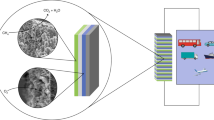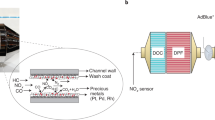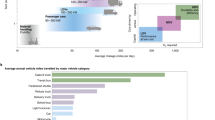Abstract
Environmental regulations in effect since the seventies have been instrumental in promoting continuous progress in the treatment of automotive exhausts, leading to an effective reduction in the emissions of carbon monoxide, unburned non-methane hydrocarbons, oxides of nitrogen and total particulates matter. This review provides an abbreviated history of the technological advances in the area of automotive catalysis achieved over almost 40 years, primarily by catalyst companies in concert with automobile manufacturers throughout the world. While technological milestones are discussed, the importance of fuel economy in decreasing CO2 emissions is acknowledged, alongside the need of decreasing the use of precious metals and improving the overall electronic control of the exhaust system. The transportation industry is facing the growing desire for a quantum jump towards non-fossil fuel vehicles. Therefore, recent developments in the area of batteries and fuel cell vehicles will also be introduced.
This is a preview of subscription content, access via your institution
Access options
Access Nature and 54 other Nature Portfolio journals
Get Nature+, our best-value online-access subscription
$29.99 / 30 days
cancel any time
Subscribe to this journal
Receive 12 digital issues and online access to articles
$119.00 per year
only $9.92 per issue
Buy this article
- Purchase on Springer Link
- Instant access to full article PDF
Prices may be subject to local taxes which are calculated during checkout





Car image reproduced from Freepik/Flaticon.


Car image reproduced from Freepik/Flaticon.
Similar content being viewed by others
References
Cohn, G. Catalytic converters for exhaust emission control of commercial equipment powered by internal combustion engines. Environ. Health Perspect. 10, 159–164 (1975).
Heck, R.M., Farrauto, R.J. & Gulati, S. in Catalytic Air Pollution Control: Commercial Technology 3rd edn, Ch. 6 (Wiley, 2009).
Laws and regulations. California Air Resources Board http://www.arb.ca.gov/html/lawsregs (2017).
Regulatory Background on the US Mobile Source Emission Control Program (MECA, 2019); http://www.meca.org/regulation/epa-tier-3-and-california-lev-iii-rulemakings
Vehicles and engines. US Environmental Protection Agency http://www.epa.gov/otaq/tier3.htm (2017).
Johnson, T. Vehicular emissions in review. SAE Int. J. Engines 7, 1207–1226 (2014).
Johnson, T. & Ameya, J. Review of vehicular engine efficiency and emissions. in WCX 17: SAE World Congress Experience (SAE International, 2017).
Regulation (EU) 2018/842 of the European Parliament and Council of 30 May 2018 binding annual greenhouse gas emission reductions by Member States from 2021 to 2030 contributing to climate action to meet commitments under the Paris Agreement and amending Regulation (EU) No 525/2013 (European Union, 2018); https://eur-lex.europa.eu/eli/reg/2018/842/oj
EU: Light Duty: Emissions (Transport Policy, 2017); https://www.transportpolicy.net/standard/eu-light-duty-emissions/
DeLosh, R. G. Dynamometer test procedures for three way catalyst screening. SAE Technical Papers https://doi.org/10.4271/770371 (1977).
Heck, R. M., Hochmuth, J. K. & Dettling, J. C. Effect of oxygen concentration on aging of TWC catalysts SAE Technical Papers https://doi.org/10.4271/920098 (1992).
Carol, L., Newman, N. & Mann, G. High temperature deactivation of three-way catalysts. SAE Technical Papers https://doi.org/10.4271/892040 (1989).
Hammerle, R. & Wu, C. Effect of high temperature on three-way automotive catalyst. SAE Technical Papers https://doi.org/10.4271/840549 (1984).
Nagashima, K., Zhang, G., Hirota, T. & Muraki, H. The effect of aging temperature on catalyst performance of Pt/Rh and Pd/Rh TWCs. SAE Technical Papers https://doi.org/10.4271/2000-01-1954 (1954).
Rüetten, O., Pischinger, S., Küpper, C., Weinowski,R., Gian D, Ignatov, D., Betton, W. & Bahn, B. Catalyst aging method for future emissions standard requirements. SAE Technical Papers https://doi.org/10.4271/2010-01-1272 (2010).
Kumar, S., Ferrari, V., Burk, P. L., Deeba, M. & Rogalo, J. Influence of phosphorous poisoning on TWC catalysts. SAE Technical Papers https://doi.org/10.4271/2003-01-3735 (2003).
Johnson, M. et al. Effects of engine oil formulation variables on exhaust emissions in taxi fleet service. SAE Technical Papers https://doi.org/10.4271/2002-01-2680 (2002).
Darr, S.T., Choksi,R.A., Hubbard, C.P., Johnson, M.D. & McCabe, R.W. Effects of oil-derived contaminants on emissions from TWC-equipped vehicles. SAE Technical Papers https://doi.org/10.4271/2000-01-1881 (2000).
Brett, P. S., Neville, A. L., Preston, W. H. & Williamson, J. An investigation into lubricant related poisoning of automotive three-way catalysts and Lambda sensors. SAE Technical Papers https://doi.org/10.4271/890490 (1989).
Williamson, W. B., Gandhi, H. S., Heyde, M. E. & Zawacki, G. A., Deactivation of three-way catalysts by fuel contaminants: lead, phosphorous, sulfur. SAE Technical Papers https://doi.org/10.4271/790942 (1979).
Ueda, F., Sugiyama, S., Arimura, K., Hamaguchi, S. & Akiyama, K. Engine oil-derived effects on deactivation of monolithic TWC and oxygen sensors. SAE Technical Papers https://doi.org/10.4271/940746 (1994).
Lafyatis, D.S., Petrow, R. & Bennett, C. The effects of oil-derived poisons on three-way catalyst performance. SAE Technical Papers https://doi.org/10.4271/2002-01-1093 (2002)
Sumida, H. et. al. Analysis of phosphorus poisoning on exhaust catalysts from compact-class vehicle. SAE Technical Papers https://doi.org/10.4271/2004-01-0147 (2004).
Matam, S. K. et al. Thermal and chemical aging of model three-way catalyst Pd/Al2O3 and its impact on the conversion of CNG vehicle exhaust. Catal. Today 184, 237–244 (2012).
Culley, S., McDonnell, T., Ball, D., Kirby, C. & Hawes, S. The impact of passenger car motor oil phosphorus levels on automotive emissions control systems. SAE Technical Papers https://doi.org/10.4271/961898 (1996).
Baik, J. et al. Effects of catalyst aging on the activity and selectivity of commercial three- way catalysts. Top. Catal. 42, 337–340 (2007).
Brett, P. S., Neville, A. L., Preston, W. H. & Williamson, J. An investigation into lubricant related poisoning of automotive three-way catalysts and lambda sensors. SAE Technical Papers https://doi.org/10.4271/890490 (1989).
Farrauto, R. J., Bartholomew, C. & Dorazio, L. in Introduction to Catalysis and Industrial Catalytic Processes Ch. 1–5 (Wiley, 2016).
Heck, R.M., Farrauto, R.J. & Gulati, S. in Catalytic Air Pollution Control: Commercial Technology, 3rd edn, Ch. 1–5 (Wiley, 2009).
Bartholomew, C. & Farrauto, R. J. in Fundamentals of Industrial Catalytic Processes 2nd edn, Ch. 1–5, (Wiley, 2005).
Heck, R.M., Farrauto, R.J. & Gulati, S. in Catalytic Air Pollution Control: Commercial Technology, 3rd edn, Ch. 6 (Wiley, 2009).
Golden, S. Perovskite-type metal oxide compounds. USPatent 6,352,955 (2002).
Golden, S. Catalytic converter comprising perovskite-type metal oxide catalyst. US Patent 6,531,425 (2003).
Gilsenti, A., Pacella, M., Guiotto, M., Natile, M. & Canu, P. Largely Cu doped LaCo1-x CuxO3 perovskites for TWC. APCAT B: Environ. 180, 94–105 (2016).
Heck, R.M., Farrauto, R.J. & Gulati, S. Catalytic Air Pollution Control: Commercial Technology, 3rd edn, Ch. 7 (Wiley, 2009).
Kaspar, J., Fornasiero, P. & Hickey, N. Automotive catalytic converter current status and some perspective. Catal. Today 77, 419–449 (2003).
Thomson, C. E., Mooney, J. J., Keith, C. D. & Mannion, W. A. Polyfunctional catalysts and method of use. US Patent 4,157,316 (1979)
Hegedus, L & Summer, J.C. Platinum-rhodium for automotive emission control. US patent 4128506 (1978).
Acres, G. J. K. & Cooper, B. J. Automobile emission control systems platinum catalysts for exhaust purification. Platin. Rev. 16, 74–86 (1972).
Hu, Z. et al. Performance and structure of Pt-Rh three-way catalysts: mechanism for Pt/Rh synergism. J. Catal. 174, 13–21 (1998).
Hu, Z. A Pt-Rh synergism in Pt/Rh three-way catalysts. Chem. Commun. 7, 879–880 (1996).
Shelef, M. & Graham, G. W. Why rhodium in automotive three-way catalysts. Cat. Rev. Sci. Eng. 36, 433–457 (1994).
Kaspar, J. & Fornasiero, P. in Catalysis by Ceria and Related Materials (ed. A. Trovarelli) Vol. 2, 217–241 (Imperial College Press, 2002).
Duprez, D. & Descorme, C. in Catalysis by Ceria and Related Materials (ed. A. Trovarelli) Vol. 2, 243–280 (Imperial College Press, 2002).
Di Monte, R. et al. Thermal stabilization of CexZr1–xO2 oxygen storage promoters by addition of Al2O3: effect of thermal aging on textural, structural, and morphological properties. Chem. Mater. 16, 4273–4285 (2004).
Sugiura, M., Ozawa, M., Suda, A., Suzuki, T. & Kanazawa, T. Development of innovative three-way catalysts containing ceria-zirconia solid solutions with high oxygen storage/release capacity. Bull. Chem. Soc. Jpn. 78, 752–767 (2005).
Zhao, M., Shen, M. & Wang, J. Effect of surface area and bulk structure on oxygen storage capacity of Ce0.67Z 0.33O2. J. Catal. 248, 258–267 (2007).
Si, R. et al. Enhanced thermal stability and oxygen storage capacity for CexZr1–xO2 (x=0.4-0.6) solid solutions by hydrothermally homogeneous doping of trivalent rare earths. J. Phys. Chem. 111, 787–794 (2007).
Kim, T., Vohs, J. M. & Gorte, R. J. Thermodynamic investigation of the redox properties of ceria-zirconia solid solutions. Ind. Eng. Chem. Res. 45, 5561–5565 (2006).
Mussmann, L., Lindner, D., Harris, M., Kreuzer, T. & Lox, E. European patent 1,046 423 B1 (2007).
Cuif, J. -P. et al. (Ce, Zr)O2 solid solutions for three-way catalysts. SAE Technical Papers https://doi.org/10.4271/970463 (1997).
Cuif, J. -P. et al. High temperature stability of ceria-zirconia supported Pd model catalysts. SAE Technical Papers https://doi.org/10.4271/980668 (1998)
Sugiura, M. Oxygen storage materials for automotive catalysts: ceria-zirconia solid solutions. Catal. Surv. Asia 7, 77–87 (2003).
Fisher, G., Theis, J., Casarella, M. & Mahan, S. The role of ceria in automotive exhaust catalysis and OBD II catalyst monitoring. SAE Technical Papers https://doi.org/10.4271/931034 (1993).
Kolli, T., Rahkamaa-Tolonen, K., Lassi, U., Savimäki, A. & Keiski, R. L. Influence of OSC material on the behaviour of metallic Pd catalysts in C2H4 and CO oxidation as well as in NO reduction. Top. Catal. 30/31, 341–346 (2004).
Devaiah, D., Reddy, H. L., Park, S. E. & Reddy, B. M. Ceria-zirconia mixed oxides: synthetic methods and applications. Catal. Rev. 6, 177–277 (2018).
Devaiah, D., Tsuzuki, T., Boningari, T., Smirniotis, P. G. & Reddy, B. M. CeMSn oxide (M=Hf, Zr, Pr, La) ternary oxide solid solutions with superior properties for CO oxidation. R. Soc. Chem. 5, 30275–30285 (2015).
Hepburn, J., Patel, K., Meneghel, M. & Ghandhi, H. Development of Pd-only three-way catalyst. SAE Technical Papers https://doi.org/10.4271/941058 (1994).
Wang, J., Chen, H., Hu, Z., Yao, M. & Li, Y. A review on the Pd-based three-way catalyst. Catal. Rev. 57, 79–144 (2015).
Dettling, J. & Lui, Y. A non-rhodium three-way catalyst for automotive applications. SAE Technical Papers https://doi.org/10.4271/920094 (1992).
Yamada, T., Kayano, K. & Funabiki, M. Platinum metals-ceria synergism in auto exhaust catalysts. Stud. Surf. Sci. Catal. 77, 329–332 (1993).
Matsuura, S., Hirai, A., Arimura, K. & Shinjoh, H. Development of three-way catalyst with using only Pd as activator. SAE Technical Papers https://doi.org/10.4271/950257 (1995).
Lui, Y. & Dettling, J. Evolution of a Pd/Rh TWC catalyst technolog. SAE Technical Papers https://doi.org/10.4271/930249 (1993).
Chen, S. -L. F., Sakakibara, J., Luo, T. & Rabinowitz, H. Layered catalyst composite. US patent 7758834 (2010).
Deeba, M., Yipeng Sun, Y., Luo, T., Leung, E., Ruvinskiy, P. & Dang, D. Layered automotive catalyst composites. US patent 2018-0178198 (2018).
Muraki, H. Performance of palladium automotive catalyst. SAE Technical Papers https://doi.org/10.4271/910842 (1975).
Theis, J., Getsoian, A. & Lambert, C. The development of low temperature three-way catalysts for high efficiency gasoline engines of the future. SAE Int. J. Fuels Lubr. 10, 583–592 (2017).
Twigg, M. V. Progress and future challenges in controlling automotive exhaust gas emission. Appl. Cataly. B. Environ. 70, 2–15 (2007).
Twigg, M. V. Automotive exhaust emissions contro. Plat. Metal. Rev. 47, 157–162 (2003).
Hu, Z. & Heck, R. High temperature ultra stable close-coupled catalyst. SAE Technical Papers https://doi.org/950254 (1995).
Hu, Z., Heck, R. & Rabinowitz, H. Close coupled catalyst. US Patent 6,044,644 (2000).
Heck, R., Hu, Z., Smaling, R., Amundsen, A. & Bourke, M. Close coupled catalyst system design and ULEV performance after 1050oC Aging. SAE Technical Papers https://doi.org/10.4271/952415 (1995).
Ball, D., Zammit, M. & Mitchell, G. Effects of substrate diameter and cell density on FTP performance. SAE Technical Papers https://doi.org/10.4271/2007-01-1265 (2007).
Deeba, M. et al. Multilayered catalyst composites. US patent 7922988 (2011).
Abe, F., Hashimoto, S. & Katsu, M. An extruded electrically heated catalyst: from design concept through proven reliability. SAE Technical Papers https://doi.org/10.4271/960340 (1996).
Hanel, F., Otto, E., Bruck, R., Disinger, J. & Nagel, T. Practical experience with the EHC system in BMW alpina B 12. SAE Technical Papers https://doi.org/10.4271/970263 (1997).
Migliardini, F., Domenico Caputo, F. & Corbo, P. MFI and FAU-type zeolites as trapping materials for light hydrocarbons emission control at low partial pressure and high temperature. J. Chem. https://doi.org/10.1155/2015/269694 (2015).
Wilenmann, M., Favez, J. & Alvarez, R. Cold-start emissions of modern passenger cars at different low ambient temperatures and their evolution over vehicle legislation categories.”. Atmos. Environ. 43, 241–2429 (2009).
Lampert, J. K., Deeba, M., & Farrauto, R. J. Catalysed hydrocarbon trap material and method of making the same. US Patent 6074973A (2000)
Xu, L., McCabe, R. W., Lupescu, J. A. Low temperature catalyst/hydrocarbon trap. US patent 944639B2 (2016)
Hochmuth, J., Burk, P., Tolentino, C. & Mignano, M. Hydrocarbon traps for controlling cold start emissions. SAE Technical Papers https://doi.org/10.4271/930739 (1993).
Luo, J., McCabe, R. W., Dearth, M. A. & Gorte, J. G. Transient adsorption studies of automotive hydrocarbon traps Reaction Engineering, Kinetics and catalysis. AIChE J. 60, 2875–2881 (2014).
Heck, R., Hu, Z., Smaling, R., Amundsen, A. & Bourke, M. Close coupled catalyst system design and ULEV performance after 1050 ˚C aging. SAE Technical Papers https://doi.org/10.4271/952415 (1995).
Otto, K., Montreuil, C. N., Todor, O., McCabe, R. W. & Gandhi, H. S. Adsorption of hydrocarbons and other exhaust components on silicalite. Ind. Eng. Chem. Res. 30, 2333–2340 (1991).
Burke, N. R., Trimm, D. L. & Howe, R. F. The effect of silica-alumina ratio and hydrothermal aging on the adsorption characteristics of BEA zeolites for cold start emission control. Appl. Catal. B: Environ. 46, 97–104 (2003).
Gu, Y. & Epling, W. Passive NOx adsorber: an overview of catalytic performance and reaction chemistry. Appl. Catal. A: Gen. 570, 1–14 (2019).
Theis, J. R. & Lambert, C. The effects of CO, C2H4, and H2O on the NOx storage performance of low temperature NOx adsorbers for diesel applications. SAE Int. J. Eng. https://doi.org/10.4271/2017-01-0942 (2017).
Ji, Y., Bai, S. & Crocker, M. Al2O3-based passive NOx adsorbers for low temperature applications. Appl. Catal. B. Environ. 170, 283–292 (2015).
Ji, Y. et al. Pt and Pd-promoted CeO2–ZrO2 for passive NOx adsorber applications. Ind. Eng. Chem. Res. 56, 111–125 (2017).
Heck, R. M., Hochmuth, J. K. & Dettling, J. C. Effect of oxygen concentration on aging of TWC catalyst. SAE Technical Papers https://doi.org/10.4271/920098 (1992).
Brinkmeier, C., Schön, C., Vent, G. & Enderle, C. Catalyst temperature rise during deceleration with fuel cut. SAE Technical Papers https://doi.org/10.4271/01-0411 (2006).
Bidner, D. et al. System and method to improve drivability with deceleration fuel shut off. US patent 7,591,758 (2009).
Zheng, Q., Farrauto, R., Deeba, M. & Valsamakis, I. Part I: a comparative thermal aging study on the regenerability of Rh/Al2O3 and Rh/CexOy-ZrO2 as model catalysts for automotive three-way catalysts. Catalysts 5, 1770–1796 (2015).
Zheng, Q., Farrauto, R. & Deeba, M. Part II: oxidative thermal aging of Pd/Al2O3 and Pd/CexOy-ZrO2 in automotive three-way catalysts: the effects of fuel shutoff and attempted fuel rich regeneration. Catalysis 5, 1797–1814 (2015).
Chincholkar, S. P. & Suryawanshi, J. G. Gasoline direct injection: an efficient technology. Energ. Proc. 90, 666–672 (2016).
Singh, A. K., Lanjewar, A. M. & Rehman, A. Direct fuel injection system in gasoline engine – a review. Int. J. Innov. Technol. Exp. Eng. 4, (2014).
Manuel, J. M., Ramos, G. & Wallace, J. S. Sources of particulate matter emissions variability from a gasoline direct injection engine. J. Eng. Gas. Turbines Power 140, 122805–122810 (2018).
Roy, S. & Baiker, A. NOx storage-reduction catalysis: from mechanism and materials properties to storage- reduction performance. Chem. Rev. 109, 4054–4091 (2009).
Forzatti, P., Lietti, L., Nova, I. & Tronconi, E. Diesel NOx after treatment catalytic technologies: analogies in LNT and SCR catalytic chemistry. Catal. Today 151, 202–211 (2010).
Farrauto, R. J., Bartholomew, C. & Dorazio, L. in Introduction to Catalysis and Industrial Catalytic Processes Ch. 14 (Wiley, 2016).
Wang, J., Zhao, H., Haller, G. & Li, Y. Recent advances in selective catalytic reduction of NOx with ammonia on Cu Chabazite. Appl. Catal. B. Environ. 202, 346–354 (2017).
Pappas, D. K., Boningari, T., Boolchand, P. & Smirniotis, P. G. Novel manganese oxide confined interweaved titania nanotubes for the low temperature selective catalytic reduction of NOx by ammonia. J. Catal. 334, 1–3 (2016).
Boningari, T. et al. Influence of elevated surface texture hydrated titania on Ce-doped Mn/titania catalysts for the low-temperature SCR of NOx under oxygen-rich conditions. J. Catal. 325, 146–155 (2015).
Praveeno, V. & Martin, M. A review of various treatment techniques to reduce NOx in CI engines. J. Energy Inst. 91, 704–720 (2018).
Lampert, J., Kazi, S. & Farrauto, R. J. Pd catalyst performance for methane emissions abatement from lean butane natural gas vehicles. Appl. Catal. B. Environ. 14, 211–223 (1997).
Honkanen, M., Wang, J., Karkkainen, M., Huuhanen, M., Keiki, R. & Akola, J. Regeneration of sulfur-poisoned Pd based catalysts for natural gas oxidation. J. Catal. 358, 253–265 (2018).
Zheng, Q. & Farrauto, R. In situ regeneration of Rhodium in three-way catalysts by aqueous ethanol injection for sustained methane emission abatement. Catal. Commun. 95, 61–66 (2017).
Scott, A. Counting the ways to store renewable energy. Chem. Engin. News 96, 14–17 (2018).
Farrauto, R., Dorazio, L. & Bartholomew, C. in Introduction to Catalysis and Industrial Catalytic Processes Ch. 15 (Wiley, 2016).
Rostrop-Nielson, J. R. in Catalysis, Science and Technology (eds. J. Anderson and M. Boudart), Ch. 1 (Springer, 1984)
Farrauto, R. J. New catalysts and reactor designs for the hydrogen economy. Chem. Eng. J. 238, 172–177 (2014).
Reisch, M. S. Air liquide plans H2 for energy market. Chem. Eng. News 3, 12 (2018).
Author information
Authors and Affiliations
Corresponding authors
Additional information
Publisher’s note: Springer Nature remains neutral with regard to jurisdictional claims in published maps and institutional affiliations.
Rights and permissions
About this article
Cite this article
Farrauto, R.J., Deeba, M. & Alerasool, S. Gasoline automobile catalysis and its historical journey to cleaner air. Nat Catal 2, 603–613 (2019). https://doi.org/10.1038/s41929-019-0312-9
Received:
Accepted:
Published:
Issue Date:
DOI: https://doi.org/10.1038/s41929-019-0312-9
This article is cited by
-
Combinatorial high throughput methodologies: the potentials in heterogeneous catalysts synthesis, screening and discovery—a review
Bulletin of the National Research Centre (2024)
-
Impact of battery electric vehicle usage on air quality in three Chinese first-tier cities
Scientific Reports (2024)
-
Atomically dispersed materials: Ideal catalysts in atomic era
Nano Research (2024)
-
Evaluating Different Strategies to Minimize cold-start Emissions from Gasoline Engines in steady-state and Transient Regimes
Topics in Catalysis (2023)
-
Opportunities and challenges in the development of advanced materials for emission control catalysts
Nature Materials (2021)



